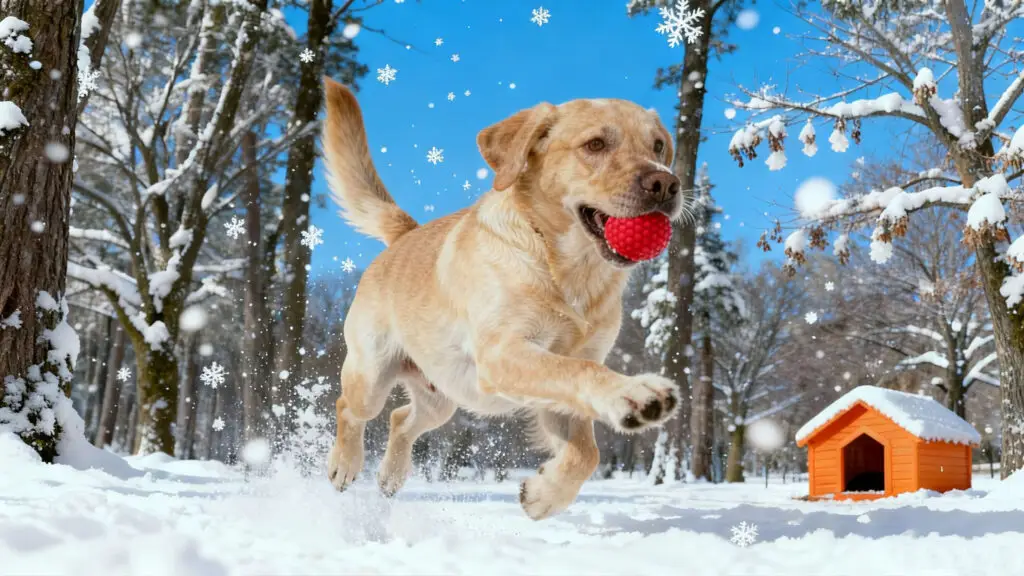As winter approaches, ensuring proper warmth for our canine companions becomes essential to their health and well-being. Cold temperatures pose significant risks to dogs, including joint stiffness, weakened immune function, and hypothermia. This guide provides breed-specific strategies for French Bulldogs, Labrador Retrievers, and Golden Retrievers, helping owners navigate winter care with confidence.
Impact of Breed Differences on Winter Warmth
Understanding how different dog breeds handle cold weather is crucial for responsible pet owners. French Bulldogs, Labrador Retrievers, and Golden Retrievers each present unique challenges when it comes to winter care, with distinct physical characteristics directly impacting their ability to regulate body temperature.
French Bulldogs, with their short coats and compact build (10-14 kg), lack natural insulation for cold weather. Their brachycephalic structure reduces capacity to warm inhaled air, making them highly sensitive to temperatures below 7°C (45°F). This breed’s low body fat percentage and minimal undercoat further compromise cold tolerance, requiring proactive protection even during mild winter days.
Labrador Retrievers possess a distinct advantage with their double coat—an outer layer of short, dense, water-resistant fur and a soft, insulating undercoat. Originally bred for Canadian winters, these medium-to-large dogs (25-36 kg) can tolerate temperatures down to 0°C (32°F) for short periods. Their muscular build and thick tail provide additional warmth in snowy conditions, though their love for outdoor activities can lead to overexposure requiring monitoring.
Golden Retrievers share the Labrador’s double coat but with longer feathering on the chest, legs, and tail. Slightly smaller than Labs (25-34 kg), their luxurious coats offer excellent insulation for temperatures around 0-5°C (32-41°F). Their origins as Scottish hunting dogs have equipped them with remarkable cold tolerance, though their longer hair requires special attention to prevent matting during winter walks.
General Winter Warmth Methods
Regardless of breed, certain fundamental winter warmth practices form the foundation of cold-weather care, addressing basic physiological needs while complementing breed-specific approaches.
Proper Shelter is essential for all dogs during winter. Indoor dogs need draft-free resting areas away from windows and exterior doors, while outdoor shelters must be insulated, elevated, and sized to retain body heat. Bedding should be thick, dry, and raised off the floor—straw provides excellent insulation for outdoor shelters, while indoor dogs benefit from padded beds with fleece covers.
Appropriate Clothing serves as an extension of a dog’s natural insulation, with selection based on breed characteristics. Coats and sweaters should cover the neck, back, and abdomen without restricting movement, while booties protect paws from ice, salt, and chemical deicers. For short-haired breeds, consider thermal vests with reflective material for both warmth and visibility during winter’s shorter daylight hours.
Nutritional Adjustments support increased energy needs in cold weather, as dogs burn more calories maintaining body temperature. Most breeds require 10-20% more food in winter, with additional calories best provided through high-quality proteins and fats. Fresh, unfrozen water must be available at all times—dehydration remains a risk even in cold weather, as dry air increases respiratory moisture loss.
Regular Grooming maintains coat insulation effectiveness. Brushing removes dead hair and prevents matting that can trap moisture and reduce insulating properties. For double-coated breeds, seasonal shedding requires more frequent brushing. Bathing should be limited during winter to preserve natural skin oils, with thorough drying after exposure to snow or rain.
While general methods apply to all dogs, breed-specific differences require more precise warmth strategies.
French Bulldog
America’s most registered breed for three consecutive years, French Bulldogs require careful winter management despite their adaptability to urban living. Their physical characteristics make cold weather particularly challenging.
Indoor Environment Optimization is critical for French Bulldogs. Maintain consistent indoor temperatures between 18-22°C (65-72°F) and place beds away from drafty areas. Consider using a heated pet mat (set to 29-32°C/85-90°F) under bedding, choosing models with chew-resistant cords and temperature controls to prevent overheating.
Strategic Clothing Selection is necessary for Frenchies when temperatures drop below 10°C (50°F). Well-fitted coats covering the chest and back become mandatory for outdoor excursions. Look for fleece-lined, water-resistant styles that don’t restrict movement or irritate skin folds. For temperatures below 0°C (32°F), add a neoprene snout cover to protect their short nose from frostbite while allowing unobstructed breathing.
Dietary Adjustments impact cold tolerance. Increase daily calories by 10-15% during winter, focusing on high-quality proteins (minimum 25% crude protein) and moderate fats (12-15%). Add small amounts of warm, cooked pumpkin or sweet potato for complex carbohydrates. Always consult your veterinarian before making significant dietary changes, especially for this breed prone to obesity.
Modified Exercise Routines are essential for French Bulldogs in winter. Their respiratory sensitivity makes cold air inhalation potentially dangerous, so limit outdoor activities to 15-20 minutes during freezing weather. Schedule walks during the warmest part of the day and avoid de-iced sidewalks. Indoors, use treat-dispensing puzzles to prevent weight gain from reduced activity levels.
Labrador Retriever
Labrador Retrievers’ dense double coats and water-resistant fur make them natural winter warriors. Originally bred for Canadian winters, these energetic dogs (25-36 kg) thrive in cold conditions but still require thoughtful care during harsh months.
Coat Maintenance Mastery maximizes a Labrador’s natural insulation. Weekly brushing with a slicker brush removes loose fur and prevents matting. During seasonal shedding periods, increase brushing to 2-3 times weekly using an undercoat rake. Never shave or trim their coat in winter, as this disrupts their natural temperature regulation system—even a slight trim can reduce insulation by up to 40%.
Controlled Outdoor Exposure balances a Lab’s love for cold weather with safety. Healthy adult Labs can tolerate temperatures down to -7°C (20°F) briefly, but prolonged exposure below -1°C (30°F) increases frostbite risk. Limit off-leash play in deep snow to 30-minute sessions with access to shelter and water. After outdoor activities, thoroughly dry their coat, paying special attention to moisture-prone areas like armpits and groin.
Paw Protection Protocol is essential for winter walks. Large, webbed feet are susceptible to injury from ice, salt, and chemical deicers. Properly sized dog boots with rugged soles and reflective strips work well for sidewalk walks. For backyard play, apply pet-safe paw balm before outdoor time and rinse paws immediately after coming inside to remove chemical residues.
Hydration and Nutrition adjustments support increased energy needs. Active adult Labs require 80-100 kcal per kg of body weight daily during cold months—10-15% more than summer requirements. Choose kibble with glucosamine and chondroitin to support joint health on icy surfaces. Ensure constant access to fresh, unfrozen water using heated bowls for outdoor areas.
Golden Retriever
Golden Retrievers bring sunshine to winter days with their cheerful disposition and luxurious coats. These medium-to-large dogs (25-34 kg) possess excellent natural insulation but require specialized care to maintain health during cold months.
Strategic Shedding Management maintains optimal coat insulation. Daily brushing with slicker brush and undercoat rake removes loose fur while distributing skin oils. During heavy shedding periods, use a de-shedding tool weekly to reduce loose hair by up to 50%. Limit bathing to once every 6-8 weeks using moisturizing shampoo to preserve natural oils.
Outdoor Safety Parameters protect Goldens from winter hazards. While their coat provides excellent insulation, they’re prone to joint stiffness in cold weather. Keep walks on paved surfaces below -5°C (23°F) to minimize joint strain. For dogs with arthritis, consider a heated bed set to 29°C (85°F). Monitor for hypothermia signs during snow play: shivering, lethargy, or decreased coordination warrant immediate warming with blankets.
Nutritional Support includes calorie adjustments and supplements. Active Goldens need 75-90 kcal per kg daily during cold months, with protein comprising 22-26% of calories. Add omega-3 fatty acid supplements (1000 mg EPA/DHA daily) to reduce inflammation. Warm bone broth makes a nutrient-rich addition to meals, supporting joint health and hydration.
Mental Stimulation prevents boredom during limited outdoor activity. Golden Retrievers thrive on interactive play and learning, making winter ideal for advanced training. Teach new commands using positive reinforcement, set up indoor scavenger hunts, and use puzzle toys that dispense food to provide mental exercise during long indoor periods.
By combining breed-specific strategies with universal safety principles, you’ll create a comprehensive winter care plan keeping your dog healthy and active through cold months. Temperature assessment should guide outdoor activities, with the “20-minute rule” for temperatures below -6°C (20°F). Ensure constant access to fresh water, adjust nutrition for increased energy needs, and be vigilant about winter hazards like antifreeze. Schedule veterinary check-ups to address health concerns before cold weather arrives.
The foundation of effective winter dog care lies in recognizing that one-size-fits-all approaches rarely work. Each breed’s evolutionary history, physical structure, and coat characteristics create distinct warmth requiring targeted strategies. By combining scientific understanding with attentive observation of your individual dog’s behavior, you can ensure their winter season is safe, healthy, and enjoyable.

